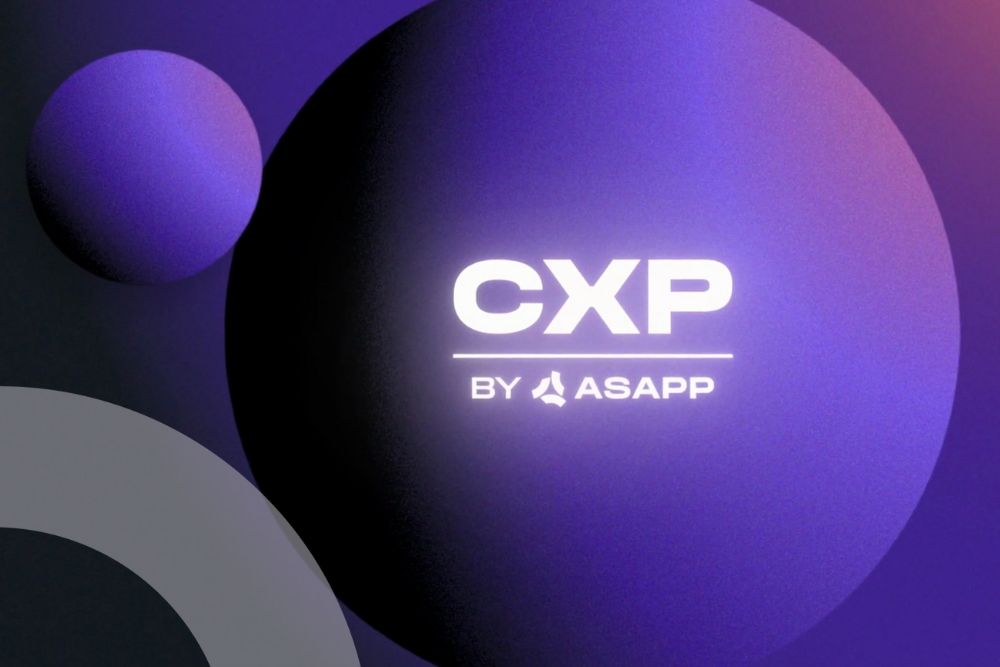Michael Lawder

Michael Lawder is Customer Experience Officer at ASAPP.
Are you tapping into the power of personalization?
For decades, one of the biggest consumer complaints has been that companies don’t really know them. Businesses may use segmentation for marketing, yet for inbound customer service, even this level of personalization is nearly non-existent. Now the race is on—because personalized service experiences are quickly becoming a brand differentiator.
When customers reach out to solve a problem, they want to feel reassured and valued. But too often, they’re treated like a number and end up more frustrated. Even if they get good service on one call, the next time they contact customer service it’s basically starting at ground zero because the next agent doesn’t know them.
As more digital customer service channels have emerged, consumers have gained more choices and digital convenience. But that creates a new challenge: people often use different channels at different times, switching between calls, web chat, digital messaging, and social media. And because those channels are often siloed, customers may get a very impersonal and disjointed experience.
The new demand for personalization requires something significantly better. Consumers now expect seamless experiences across their relationship with a company—and without it, brands will struggle to earn repeat business, let alone loyalty. In fact, nearly 60% of consumers say personalized engagement based on past interactions is very important to winning their business.
Increasing value with a unified channel journey
Knowing your customers means providing seamless continuity wherever they engage with your brand. Typically, the experience is fragmented, and consumers have a right to expect better. They provide a considerable amount of data through various channel interactions, and 83% of consumers are willing to share that data to receive more personalized experiences.
When a company barely knows them from one engagement to the next, how do you think that affects their trust in the brand?
It’s no surprise that 89% of digital businesses are investing in personalization. Cutting edge technologies are eliminating the friction and fragmentation of multi-channel journeys, by meeting customers with full context however they make contact. With a unified, AI-powered platform for customer experience, companies can seamlessly integrate voice and digital capabilities—and ensure customers are greeted every time with an understanding of their history with the company, where they’ve been and what happened in previous interactions It gives customers greater flexibility and ease for engaging using their preferred channels, which can dramatically improve satisfaction ratings and NPS scores.
Another powerful benefit of multi-channel integration is that it enables contact centers to think in terms of conversations instead of cases. A unified platform weaves together voice and digital messages into a cohesive thread for a given customer. Any agent can easily step in and join that conversation, having all the right knowledge about the situation and visibility into previous interactions. That continuity enables agents to provide more personalized attention that helps ensure the customer feels known and valued.

Customer service needs to be about conversations, not cases. Creating intelligent, personalized continuity across all engagement channels shows customers you know and value them—and that’s the great CX that wins loyalty.
Michael Lawder
Improving proactive engagement with personalization
Tapping into a wealth of customer data from many different channels, companies can take customer experience to the next level. Using AI and machine learning, you can build more comprehensive customer histories and serve up predictive, personalized action plans specifically relevant for each customer.
I’m talking about gaining a holistic picture of when, why, and how each customer has engaged over their lifecycle with your company. That opens up significant opportunities, such as:
- Improve customer experience and earn loyalty
- by providing highly personalized support each time someone reaches out.
- Increase customer lifetime value
- with more relevant and timely proactive engagement that is more like personalized conversations, all based on data-driven insights.
- Boost marketing ROI
- using customer data to develop persona-based segmentation strategies and nuanced messaging driven by sentiment analysis and a deeper understanding of intent.
Most consumers now expect companies to know them better and see that reflected in their communications. And the demand for personally relevant experiences isn’t just about marketing—it’s across the journey, including customer service. That’s why ASAPP technology is so compelling.
Support interactions are often the defining moments that dictate how people feel about a brand. The more you can personalize those customer service moments, the more you will earn loyalty, and even word-of-mouth referrals as your happy customers become brand advocates.
The keys to CX success in 2022 (and beyond)
The past two years have fundamentally and permanently changed how we think about and approach customer service. Faced with an ongoing pandemic, the shift to remote work, supply chain disruptions, and the “Great Resignation,” companies have been forced to adapt and evolve at an incredible pace, re-examining the role of customer service and the critical link it provides between their customers and their brand.
As we move into the new year, brands will need to continue to advance every aspect of CX to stay competitive, as customer expectations (and frustrations) reach an all-time high. But how to best serve customers, grow revenue, and empower workers, all while keeping costs down? Here are four things forward-thinking CX organizations are doing right, right now.
Elevating the Frontline Agent Experience
Contact center agents represent the voice of your brand. It has always been one of the most difficult and important jobs in any company, and an underserved part of the customer + brand ecosystem. But in the wake of the Great Resignation, there is an even more critical need for companies to focus on agent and employee satisfaction.
It has become increasingly difficult to attract and retain talent in the current environment. With demand at an all-time high, agents are migrating to companies that value them and prioritize employee well-being, flexibility, and engagement. To reduce churn and maintain a motivated workforce, leading companies are actively working to make agents’ jobs better.

If you want to provide a great customer experience, start with the voice of your brand—your agents. When we look at the fundamental forces at play in evolving CX, it is essential to focus on the people at the center of the conversation.
It starts with focusing attention and resources on training that engages employees from day one and accelerates time to proficiency. Employing AI to improve onboarding and coaching is one way forward-thinking companies are flattening the learning curve. Advanced machine learning can now analyze every word and action taken by top agents in real time, compiling best practices to guide others on how to handle any customer request. With this streamlined approach, new agents get up to speed faster while building competence and confidence.
In addition to training, agents need technology that supports, not overwhelms. Many today are faced with a jumbled stack of applications and processes that can make completing tasks difficult. Companies are starting to be more mindful of the entire journey agents take to fulfill each customer request. With that knowledge, they can identify where to engage automation to reduce tedious tasks and streamline workflows, enabling agents to concentrate on what they actually want to do—help customers.
Making Customer Experience a Feature
There are more ways to engage with customers than ever before. Due to the global pandemic, digital channels more quickly became the norm, and companies are making themselves available on a growing number of platforms (e.g., Apple Messages for Business, Google Business Messaging, SMS, and more). Most consumers now expect unlimited access to their favorite brands through seamless multichannel service. The companies succeeding in CX are those that continue to move aggressively towards these digital and asynchronous experiences. Creating a cohesive cross-channel experience is key to both automated and human-driven modalities, allowing customers to engage wherever and whenever, while supplying agents with critical context to deliver personal and relevant experiences.
To maintain a competitive advantage, brands must provide memorable, elevated service that builds loyalty (and increased lifetime value). This means experiences that bring customers back again and again, making them fans of the company based not only on the product purchased, but how the company took care of them during a “moment of truth.” We are seeing more companies emphasize experience, now fully aware of its potential to differentiate their brand—and possibly turn their cost center into a profit center.
Using Data to Fuel CX Innovation
The growing move to digital, increase in smart products, and evolution of tech to capture customer behavior all mean more data for companies to digest. Faced with an almost overwhelming volume of customer and operational data, leading brands are examining how best to use this information to both improve processes and deliver more effective service. Those at the forefront have figured out how to make the data do the work for them, using AI-powered analytics to inform everything from marketing strategy to agent onboarding.
Customers today expect hyper-personalized interactions with brands, and are more likely to respond to communications that understand their specific interests and history with the company. CX teams can now employ AI to learn from every interaction with an individual, remembering and adapting to their personal preferences to tailor engagement efforts. To truly improve business outcomes, organizations have adopted platforms that make full use of AI to feed analytics and gain actionable insights—in real time. And thanks to the availability of data on past interactions along with advancements in natural language processing, companies can even engage AI services that simulate customer scenarios to train agents in more dynamic, real-world settings before they get on an actual call or chat.
Building a Continuous Cycle of Automation
As noted, one trend increasingly evident in CX is the growing confidence in and adoption of AI. The key here is finding the right balance between automation and humanity. Customers still want human interaction, perhaps more than ever after years of less than optimal chatbot conversations. While bots continue to serve a role, there is a push now to find smarter ways to engage automation for both customers and agents.
What is commonly referred to as “agent assist” has become a core capability. But this basic feature is only the beginning of how CX teams can use AI to achieve significant productivity gains and better customer experiences. The most advanced companies are exploring ways to integrate AI-driven capabilities throughout agent workflows. This unlocks the ability to not only dramatically streamline processes, but power more and more automation using the knowledge gained through machine learning. As the ML models study each interaction, they continually feed improvements to the automated experience, identifying opportunities to both further support agents and enhance self-service for customers.
Looking to the Future Now
Today’s leading companies understand that to compete they must focus on the entire ecosystem of the customer journey—and that starts with frontline agents. Ultimately, we know:
- Happy, engaged agents provide superior customer service
- Elevated experiences are the key to winning customer loyalty
- Experiential data fuels analytics to produce valuable insights
- These insights can help enhance automation, improving engagement
To succeed in 2022 and beyond, organizations not only need to understand this cycle, but foster each part of it. That is what ASAPP helps our customers do everyday.
Four AI-centered CX insights from fortune 500 CXOs
In recent years, the rapid advance of new data and mobile applications has created a heightened threshold for customer expectations. ASAPP and a suite of forward-looking Chief Experience Officers (CXOs) who represent companies with over $450 billion in market value met to discuss how machine learning (ML), speech recognition, and natural language processing (NLP) are generating higher agent productivity, efficiency, and cost reductions.
Four key AI-centered insights arose from the CXOs who see 2021 as an opportunity to realize the promise of artificial intelligence to radically improve customer experience (CX).
1—Automation creates opportunity for emotive, human-driven service
On the surface, “automation” and “human-driven” seem like two opposing forces. A legacy approach considers automation solely to enable customer self-service, taking human agents out of the customer journey. While self-service will persist in specific applications, automating contact center agents’ repetitive tasks allows a focus on what matters most: providing excellent customer service and representing a brand positively.
AI is opening new avenues to create personalized experiences for customers. With an AI platform, agents know what the customer is facing at a given time, their history with the company, and their communication preferences. Automating their administrative tasks in note-taking and multitasking enables agents to be stronger brand ambassadors in spending more mental energy providing an emotive, high-touch, response to customer needs.
2—AI-driven real-time insights is the next big opportunity for supervisors and coaches
Previously, an in-person presence at call centers afforded managers the ability to monitor and assist agents shoulder-to-shoulder. But in today’s digital workplace, managers have turned to less streamlined methods of using webcam and Slack to support agents. This approach has made it harder for managers to supervise and coach teams, and the introduction of new digital systems has added increasing complexity for front-line agents.
CXOs are beginning to see the promise of ML, NLP, and automatic speech recognition technologies to power live voice transcription. These AI technologies enable managers to supervise and support agents in real-time, guiding agents at the moment they need assistance. After each customer engagement, ML-generated reports and summaries allow managers to digest previous interactions, understand where agents are facing challenges, and improve agent performance. With the AI analyzed data, managers can adjust strategy and coaching in real-time to nimbly respond to the business challenges they face.
In the near future, CXOs expect the confluence of ML, NLP, and automatic speech recognition technologies to provide insight for the next golden opportunity: determining caller intent to more rapidly detect what a caller needs, assess their emotional state, and have them automatically routed to the appropriate agent.

CXOs are excited by the opportunities AI presents. They expect this technology to help their organizations be much more productive and at the same time, differentiate themselves by providing exceptional customer experience.
Michael Lawder
3—Measure what matters for holistic data-driven decision making
Thanks to the advance of ML, businesses are able scale pattern recognition and automation from their own data. In 2021, the businesses we speak to are going beyond “bean-counting” to unearth correlation-driven insights for strategic business decisions. Outliers and anecdotes are steadily coming together to illustrate, for example, that mobile device users are more willing to have synchronous conversations than desktop users—an insight which may affect routing processes. To detect these patterns, CX teams are looking to ensure that they have individuals with the knowledge to contextualize the data and to build systems to reliably measure it.
However, in the effort to become a digital-first business, building a comprehensive data lake remains a challenge. Businesses are still struggling to compile timely, quality data at a granularity that can be integrated with other data sets. The preservation, and architecture, of legacy systems has led to continued data silos that makes it hard for decision-makers to see the big picture in the customer journey. CX leaders should demand more from their IT teams and service providers to streamline this data to successfully arm businesses and teams to make changes.
And it’s not just technical IT teams who have a responsibility in building this data treasury. All employees have a role in ensuring that the business is flagging data for data driven decision making. The first step begins in making a cultural mind shift to view data as an important corporate asset.
4—Today’s AI and digital technology shouldn’t be used with yesterday’s paradigm
Many of the à la carte solutions found in today’s contact centers were built for a different time. In decades past, businesses relied on outsourcing to balance costs and scale service which often came at the cost of the customer experience. In the 2010s, IVRs and chatbots offered a way to triage workloads but rarely provided a stellar experience for customers. Today, many contact centers are left sustaining a costly myriad of legacy systems that were not designed for a cohesive customer experience. A real transformation to improve customer experiences requires a rethink of how the customer journey operates.
At ASAPP, we’re doing this by putting a focus on making people better with AI. This has meant a change in everything we create from the ground up for vertically integrated AI and human productivity. We’re changing how we measure ourselves, and interact with customers. For example, IVRs and legacy systems may deliver cost savings, but they may actually exacerbate customer frustration. An analogy I like to use when describing this new paradigm for CX is like building a train to fly. Instead of spending the significant and inefficient resourcing to make trains fly, at ASAPP, we’re building an airplane.
Chief Experience Officers are excited by a future driven by AI: making organizations highly productive and effective by augmenting human activity and automating the world’s workflows. I can’t wait to see what new insights we’ll unearth at our next meeting.
Want to see what makes people so excited to partner with us? Get in touch, or give me a tweet at @michael_lawder.
Is your customer experience always getting smarter?
Pressure to deliver better customer experiences at lower cost is a real challenge. Balancing these two competing priorities is driving innovation, with the real paradigm shift coming from innovations in machine learning and AI.
Automation already plays a role in reducing costs, but when the sole focus is on efficiency, the customer experience often suffers. You risk frustrating customers who express their dissatisfaction in social media and worse, leaving your brand. I think the future of customer experience is using AI to create a self-learning, digital-first business—one that gets smarter all the time—to address many challenging factors at once.
Machine learning is key. It deepens your understanding about customers to better identify where automation works best, and how to personalize interactions across channels. And it empowers agents with predictive knowledge to make them significantly more efficient and productive.
Automate away the routine, not the CX
Ideally, the goal of automation is to accelerate service delivery and resolution for customers, in ways that improve customer experience and lower costs. However, automation should not be exclusively about eliminating human involvement. Satisfying customers without live intervention needs to be part of it; but you also want labor-saving technology that makes live agents more efficient and effective.
Chatbots are great for automating simple tasks. But it would take an army of people to imagine and program all the possible scenarios to fully replicate the experience of speaking with a live agent. That’s why I think automation is most empowering with a system that continuously learns from agents the right thing to say and do in every situation. You can then apply those learnings to automate more and more interactions into predictive suggestions. And over time, those suggestions become actions that the system can automatically handle on behalf of an agent, leaving the agent to more complicated tasks that require a human touch.
In other words, automation becomes the brain of the process, not the process itself. Yes, it powers automated self-service. AND with predictive knowledge, it shortens the time it takes for agents to address issues, which means they can serve customers better, faster, and easier.
Grow smarter agents, smarter channels
Even if you automate away common tasks, many situations still need the human touch. You want those experiences to keep getting smarter as well. Empowering agents with machine learning predictive knowledge ensures they can handle any situation as effectively as your best agent. Real-time conversational analytics and machine learning fuel proactive suggestions that make agents more efficient at handling complex conversations, so every agent can address specialized topics and scenarios.
Intelligent, labor-saving technology also helps solve the common customer complaint about fragmented experiences. People get frustrated when they can’t get help through their preferred digital channels, and even more annoyed if they need to switch channels mid-conversation and have to start all over again.
An integrated, self-learning platform enables seamless continuity across all service channels. Digital messaging, in particular, allows customers to pause a conversation (and even jump from chat to texting or social media to chat), while keeping a continuous thread going until they get everything they need. A smart system ensures they don’t have to start over, saving time and effort for both customers and agents.

At every company I’ve ever worked, any time we delivered a great experience to a customer, their lifetime value went up. Delivering smarter, faster, more personal customer service is at the heart of every great customer experience.
Michael Lawder
Increase value with continuous learning
Enabling a customer service organization to continuously get smarter is one of the things I love most about AI. Over time, you keep learning new ways to automate for efficiency, new ways to help agents work more productively — and also new ways to extract value from a wealth of data.
An AI-driven system enables you to harness volumes of data from every conversation across every channel. It analyzes real-time voice transcription and text data from multi-channel digital messaging for increasingly valuable insights you can put to use. It also factors in voice of the customer data from across the enterprise for more informed decision-making.
Intelligent conversational analytics give you a competitive edge. You can better know your customers to provide more personalized support. You can equip agents to resolve issues faster. And you can ensure the knowledge of your best agents is available for everyone to use.
It’s the ultimate digital-first strategy, enabling companies to optimize customer service and CX in very focused ways that increase satisfaction and drive loyalty.
But wait, there’s more. Conversational insights also deliver value well beyond the contact center. Sales and marketing can gain substantially deeper understanding of customer concerns, buying patterns, and decision drivers. This enables the business to deliver more relevant and personalized predictive offers to increase revenue and marketing ROI.
Go big with transformative results
I’ve been in customer experience for over two decades, starting as a call center agent long ago, and only now am I seeing AI really deliver transformative results. ASAPP enables businesses to continuously get smarter, reinventing customer service in ways that translate into retention and brand loyalty to improve the bottom line.
Why companies who want true VoC need to engage the power of AI
The best businesses succeed by developing a holistic understanding of their customers. Most, if not all, consumer companies have a Voice of the Customer (VoC) program, intended to capture and analyze feedback, leveraging the insights to drive both strategic and operational improvements across the business. While the intent of these programs is critical to constant improvement, the tools that have been available to CX professionals fall short of delivering what they really need.
Surveys and samples only give a partial view
Many organizations build VoC programs solely on a “survey and score” foundation. When done right, surveys can play an important role in any VoC program. But due to their low average response rate and general bias, they provide organizations with a limited view of the overall customer experience and the quality of service that is being delivered by your organization.
An overreliance on surveys has other pitfalls, too. Relationship-based surveys, for example, evaluate general brand satisfaction, but often fail to provide clear feedback on the internal processes, people, and frontline events that contribute to customer experience. On the flip side, transaction-based surveys capture feedback in the moment, but tend to lose sight of what the overall relationship looks like from the customer’s point of view.
Other companies might record calls, then either listen to or transcribe a subset of these calls. This approach also limits analysis to a small sample of customer interactions.
Analyzing only a fraction of your calls fails to tell the whole story. Yet companies rely on this data to make important decisions about product, sales, and marketing initiatives as well as contact center operations.
What’s more, with both of these approaches, there can be a significant time lapse between capturing the data, gaining insight from that data, and putting that insight into action. The truth is that most of us in the customer experience world have never had a full view of the quality of service we are delivering to our customers, and the opportunities that exist to improve the way in which we serve our customers across the enterprise.
AI elevates VoC with new possibilities
Artificial intelligence fuels new options for gaining more comprehensive customer insight. And, for putting that insight into action. Forward thinking CX leaders are excited about mining this wealth of data and are heartened to learn that they won’t need an army of data scientists on staff to do it.
Highly accurate transcription is key
The best of these new solutions start with highly accurate real-time transcription of every call. Transcription is not the goal, but a means to an end. However the importance of the quality of transcription can’t be overstated, as this is the fuel for meaningful analysis. More on this here.

AI solutions that use machine learning models custom trained on a company’s lexicon are—not surprisingly—far more accurate than solutions using generic models trained on everyone’s data. Consequently, they can deliver far more value.
Michael Lawder
Getting this data in real time gives companies the opportunity to take action instantly instead of waiting weeks, months, or even longer to address customer needs. And having it for every call gives companies a much fuller customer perspective.
Rich actionable insights
The real value comes not in just getting the data, but in being able to put it to use in meaningful ways. Beyond accurately transcribing customer conversations, an AI-driven VoC program can:
- Analyze sentiment and even predict CSAT and NPS scores
- Capture customers problem statements
- Classify intent at a useful level of detail
- Spot correlations between things—for example: callbacks or sentiment by agent, intent, or length of call
- Highlight trends and anomalies in customer conversations
- Alert supervisors of coaching need by agent or topic
- Automate summary notes, providing cleaner data for analysis and better records for future customer contact
For the first time, you can effectively measure the quality of service you are delivering for every product, every interaction, every agent.
Cultivating VoC of this depth can do more than help manage and optimize CX operations. It has the power to influence business as a whole. CX leaders become the ultimate advocate for the customer, able to synthesize customer wants and needs as they relate to every stage of the customer journey. This elevates their stature in the organization, as they become trusted sources for insights that inform key decisions and strategy aimed to build customer loyalty and grow revenue. If you’d like to hear how companies in your industry are using AI-driven speech intelligence solutions in their VOC programs, drop us a line at ask@asapp.com.
Think beyond the bot: 3 proven strategies for digital-first business success
Everyone’s talking about the importance of digital-first customer experience, especially these days—but you have to think bigger than that. It’s not enough to just have a great mobile app or self-service chatbot. Market-leading success relies on having a digital-first culture that drives your business and meets your customers where they are.
In simplest terms, ‘digital-first’ means making your operations as digital and mobile-friendly as possible, including enabling seamless communication across multiple responsive, persistent and asynchronous digital channels. Particularly in customer service, digital-first operations and the notion of engaging with your customers in the same place that they talk to their friends and family is a game-changer.
I’m not talking about technology replacing people, but about using the latest digital capabilities to make your organization radically more efficient and productive, and improving the customer experience at the same time. It’s all about empowering employees to do their best work, and meeting customer needs faster and better, wherever they are and whenever they need you.
Where should you focus first? I think a digital-first culture for customer service relies on a few fundamentals for meeting today’s demands. Let’s look at three proven strategies that are powering market leading companies.
1—Be where customers are—service on the go
Customer service is all about building relationships with your customers. In a digital-first world, those conversations are now across many channels from online support portals and webchat, to email, in-app, standard text messaging, and social media. Among all the options for digital engagement, asynchronous messaging has emerged as a clear winner with consumers. In fact, messaging has been the dominant way in which people communicate since over a decade ago. It makes sense that they want to engage with brands they love in the same place, given the familiarity and convenience.
For digital-first customer service, providing messaging capabilities is now the essential way to be there for customers in the moment. It gives customers a fast, convenient way to reach out, and can make it easier to resolve service issues cost-efficiently on the first contact.
Big tech leaders paved the way with technologies like Apple Business Chat and Google Business Messaging, enabling companies to integrate messaging at multiple touch points. New AI-powered solutions are now taking it a step further.
I like to call this the ‘asynchronous revolution.’ Digital-first leadership now demands multimodal customer service that supports ongoing conversations. The “start and stop” flexibility that people love so much in their personal messaging is now a business-critical interaction model that today’s digital consumers expect.
2—Make conversations seamless across channels
Being there for customers in digital messaging is key—but what if they need to pause the conversation or switch channels in the middle of an issue? Typically it means starting all over again, which is a frustrating experience. When people have to explain their problem to multiple agents, customer satisfaction drops off a cliff.
Delivering true omni-channel support is the next essential in a digital-first business, and it is finally here.
Whether consumers reach out via messaging, webchat, or voice, all of these channels must be intelligently integrated to ensure customer service agents really know each person. Employees need to be equipped with the right interaction history and procedural knowledge to quickly move toward resolution, no matter where or when that agent stepped into the conversation.
Many companies are finding that’s the most critical customer experience problem to solve, and the biggest source of frustration for consumers who need help. That’s why I’m so excited when I see new technologies seamlessly unify and thread conversation histories across channels. Innovative solutions are finally bringing a holistic approach to customer service.
Someone can request assistance in an app, then switch to a webchat, mobile messaging, or even voice, and any agent will know all the relevant details. It ensures the customer has an easy, cohesive experience, and enables agents to work more efficiently.
In this way, AI helps fuel a digital-first business and empower support and sales teams to treat every customer interaction as a moment that matters.

AI amplifies the effectiveness of digital-first channels and new techniques help to accelerate adoption. Powering digital and mobile touch points with data-driven intelligence also radically increases productivity at a lower cost—while delivering responsive, personalized customer experiences that win brand loyalty.
Michael Lawder
3—Empower employees with predictive capabilities
Once you’ve got digital messaging and omni-channel support in place, it’s time to kick it up a notch by augmenting customer service agents and sales teams with predictive and highly contextualized knowledge, powered by self-learning AI models. Most companies have vast volumes of data that can be harnessed to make support and marketing efforts substantially more productive.
Here’s where cutting-edge AI solutions really stand out. They can transcribe and analyze digital and voice conversations in real time, and integrate those insights with other transactional and historical data. The system can then proactively guide agents and sales reps with the most accurate and relevant information for a given customer need or situation, ensuring the best answer and outcome every time.
Those ‘conversational analytics’ translate into predictive insights that deliver powerful benefits:
- Dramatically improves productivity
- when your workforce knows exactly what to say and do through every interaction, without having to dig for details.
- Captures the knowledge
- of your best agents and sales reps. Sometimes that’s the best ‘data’ you’ve got, and it’s a lot more valuable when everyone can access it.
- Delivers data-driven intelligence
- to sales and marketing teams, making it easier to improve your operation and tailor customer experiences based on predictive insights instead of best guesses.
Ultimately, I believe the power of AI and predictive technologies like ASAPP are defining the future of digital-first business. This is the first time in the history of the customer service industry that we can simultaneously meet customers where they are, drive revenue growth, deliver a better customer and employee experience—and do it all at lower costs. And it’s about time.
Modern CX Teams: What do they have that you don’t?
Long before the pandemic, consumers made the digital shift—but business has been slow to catch up. For over a decade, texting and digital messaging have been the most popular ways to communicate. Yet, the average Fortune 500 company still spends 80% or more of their contact center budget on voice calls—where the experience is worse and the cost is higher. Customers are handled more like anonymous callers, and the levers to drive efficiency and quality are limited.
For brands to stay competitive, customer service needs to modernize, using new technologies to really know customers and be there for them where and how they want to be supported. Call centers will still be part of the mix, but they need to deliver more value, and be integrated into a larger, holistic omni-channel support strategy. By embracing innovative capabilities, companies can deliver cost-efficient human-centric digital experiences that help win and keep customers.
Rethinking digital communications
When customers have a question or a problem, they want quick, convenient resolution on their preferred communication channel. Today that most often means digital. Customers may want to use self-service tools, reach out on social media, and chat, text, or message in a variety of ways. The best brands will make it an easy, personalized experience that nurtures loyalty and increases lifetime value, regardless of channel. There is real power in engaging with your customers in the same place they talk to their friends and family.
Many budget-minded executives see digital communications solely as a way to minimize costly engagement with customers. They measure success in deflection and containment. But that’s not a sustainable (or logical) approach. What if, instead, your digital capabilities made every interaction substantially better?

Reimagining CX with AI at the core dramatically changes the paradigm. Companies can deliver great experiences AND drive new levels of efficiency.
Michael Lawder
AI innovations are making that possible. Today, businesses can not only deliver smarter digital channels, but empower better customer service communications all around.
One of the biggest wins is meeting customer needs on the first contact. When an AI-powered solution integrates all your digital communication channels, both agents and customers have a greater opportunity to get it right the first time. If a customer does need to follow up on something, a smart system provides all the relevant details so any agent can quickly move things forward instead of starting all over.
That’s one part of a better, modernized customer experience. Taking it further, AI-driven solutions also make agents significantly more productive through every interaction. Machine learning augments CX teams with the right knowledge at the right time for faster, easier resolution. I love that some of the most advanced machine learning technologies are being used to help make people (in this case, agents) better.By dramatically increasing efficiency, customer care agents can deliver a more personalized and contextual interaction — turning potentially negative experiences into real loyalty moments.
Fueling conversation-powered operations
Conversations are the heart of customer service, and digital-first technologies can make those communications operationally more efficient. In real time, it means faster resolution for shorter and more concurrent interactions, at lower costs. In the long view, it provides a wealth of data for machine learning insights, providing ‘conversational analytics’ to fuel strategies and actions that help the business.
Think about ‘voice of the customer’ programs, where feedback mostly comes through surveys. What if you could easily uncover insights from conversations across many touch points?
After decades leading contact center organizations, I think the future of workforce management is in conversation-powered operations. Companies have a goldmine of data that isn’t being tapped. With the best of modern technology, machine learning can extract valuable customer sentiment from 100% of contacts with zero manual work instead of the old way of listening to calls and reading transcripts.
It can rapidly analyze thousands of agent conversations for internal quality assurance to improve compliance, soft skills, and process optimization. This modernization provides a significantly greater ability to understand the quality of service agents are delivering, and opens a window of insights into the enterprise. It’s a faster, smarter way to identify how and where to make both transactional and strategic improvements that are better for the business and the customer experience.
Humanizing your agents
Circling back to empowering agents, modern CX teams recognize customer service agents are the voice of their brand and should be brand ambassadors. We all know the adage about ‘making every agent as good as your best agents’—but you can only get there if you support them well. Instead of juggling multiple tools and inefficient processes, agents need to be able to focus on ensuring each customer feels known, valued, and supported.
That’s the kind of experience that powers a brand. And that’s where ASAPP really shines.
ASAPP modernizes CX with a streamlined, unified platform to easily support customers across channels. With AI-driven predictive knowledge, agents know what to say and do to serve each customer better and faster. It uses the power of technology not to replace the human touch or hide from customers, but to make contact more personalized. Ultimately, that’s the path to greatness for a brand…empowering both sides of the conversation with the right balance of digital efficiency and an emotional connection. That builds relationships with your customers and makes great customer experience a core part of the value proposition of your brand.
It's time to rethink customer service
It’s time to rethink customer service. For decades, I’ve seen how contact centers are pressured to focus on costs and end up sacrificing quality. It’s easy to understand why: Customer service is one of the largest operating expenses at most consumer companies. But, when the drive for efficiency comes at the expense of customer experience—and ultimately loyalty—companies often lose as much as they gain.
A no-win situation for companies and the consumers they serve
Here’s a typical scenario: To save money companies hire thousands of contact center workers in low cost locations who have never used their product or service, give them 2-3 weeks of training, and unleash them to interact with customers. They invest in bots to keep customers away. And they may try some chat channels, with hope of having agents help more than one customer at a time. None of these works particularly well to serve the customer. So, they may try one and then another—and because each channel is in a separate system—they have to start all over with every attempt.
The critical need for a new strategy
Meeting customer needs and controlling your brand have never been more challenging—nor more important. Consumers now have a powerful voice to sway opinion, their expectations can change with a tweet, and brand loyalty is fleeting. People in this mobile-first, digital-first world expect fast, anytime, anywhere service, but they also want companies to know and value them. Customer service needs to deliver all of that, yet too often it misses the mark because frontline workers aren’t set up to be successful.

Instead of using technology to keep customers away from your agents, use it to empower those agents to deliver great customer experiences. It will pay off in both greater productivity and increased customer and agent satisfaction.
Michael Lawder
Customer care agents are the voice of your brand. But what happens if they have to struggle to solve problems with insufficient knowledge and an array of inefficient tools? It’s no wonder many businesses have an agent annual attrition rate that often reaches 100% or higher—while customer satisfaction is going down.
After two decades working every level of customer service at top brands like Apple and Samsung, I know there’s a better way.
Empower every agent to be their best
Companies don’t have to choose between reducing cost and providing great customer experience. We just need to leave old thinking behind, and take advantage of emerging technologies that enable contact center employees to do their best work.
The key is in supporting agents, helping them to be more productive—and more engaged and satisfied with their jobs. When I think about the agent and contact center of the future, a few essentials rise to the top:
- Make it easy to focus on customers.
- Typically, agents spend most of their time and attention hunting for information across multiple systems, and manually working through processes. Meanwhile the customer waits and gets frustrated. Giving agents a streamlined, integrated system they can learn in hours instead of days will both increase operational efficiency and drive higher customer satisfaction.
- Give every agent instant access to the best knowledge available.
- It’s time we put the information agents need at their fingertips using the power of AI. No more relying on shoulder-tapping a coworker for answers or putting customers on long holds while culling through virtual libraries. Innovative technologies can predictively deliver the right knowledge and procedures, so agents know exactly what to say and do to best serve customers and solve problems faster. Augmenting workers with AI and machine learning means you don’t eliminate the human touch but make it dramatically more productive.
- Support customers seamlessly anywhere they are.
- Digital-first is now the name of the game, and that includes making it easy for customers to solve a problem or meet a need using any channel they prefer. Suppose someone starts on a call but needs to drop, and wants to finish resolving their issue later via chat or texting. Contact centers need to provide that continuity across channels, so agents can instantly pick up where things left off and customers have an effortless experience and feel that you know them. The more convenience and simplicity you provide, the more likely you will earn loyalty and build trust, driving lifetime value along the way.
The new demands of customer experience require a new approach for customer service. That’s why I’m so passionate about working at ASAPP. For the first time in decades, I see the promise of artificial intelligence in action. With a unique technology solution, ASAPP solves two primary challenges that are typically in conflict. Empowering agents to be more productive reduces costs and improves the bottom line, and at the same time creates a simpler and effortless customer experience that drives loyalty and retention for your brand.
It’s customer service for the future—right now, when consumers and businesses need it most.
Transforming the customer experience: My full-circle journey to ASAPP Chief Experience Officer
Today, after spending almost 25 years running customer service and experience teams for large brands like Apple, Samsung, and EA, I joined ASAPP, a truly amazing company transforming customer experiences and innovating contact center operations with next generation, AI-powered software.
Why join an enterprise software provider after being a practitioner for so long? It’s an interesting next step in my own personal journey starting at Apple where I realized that the role of an agent is one of the most important jobs at any company, as they are the voice of your brand.
ASAPP
I met ASAPP CEO Gustavo Sapoznik and the team at ASAPP late last year, and was genuinely shocked to find a company that delivers on the promise of transforming customer experience. What other companies said they were working on or thinking about, ASAPP had already built. And not just built…but built well, paying attention to every last detail of the experience for both customers and agents, bringing true innovation to the technology that powers this industry in a way that I have not seen in 25 years.
It turns out that helping enable other companies to deliver best-in-class experiences vs. leading an operation directly is two sides of the same coin. Plus the people, the culture, and the product here at ASAPP speaks to the heart of a company and what truly matters. It’s why I am here.

I look forward to helping companies deliver best-in-class customer experiences.
Michael Lawder
I’m excited for this next part of the journey into the customer experience. While these remain uncertain and challenging times for people—including everyone in the customer experience industry—it’s an opportunity for change and growth in these moments of truth. This new normal is forcing all of us to think differently and businesses have the opportunity to address underlying challenges and build strategies and plans to survive and thrive through these times. I joined ASAPP because I’ve seen how powerful its artificial intelligence capabilities are in driving innovative and new customer experiences—including remote agents—and how critical this technology will become in transforming the way customer service and experience operate, now and in the future.
As ASAPP is a fundamental research-driven organization, I’ll be tackling opportunities to combine the best ingredients businesses will need in the future to build a best-in-class customer experience team that allows them to outpace their competitors.
For the first time, companies don’t have to sacrifice high-quality experiences in the name of reducing costs and I’ve been inspired by the leadership and team here at ASAPP. We’re on a journey to help every company deliver awesome customer experiences and radically increase agent productivity.
Let’s get started!
When automation is ‘all or nothing’—what are you missing?
Automation in customer service is all about reducing costs—but it only pays off if it resolves customer issues and makes them happy.
For decades, bot technology (in the form of chatbots and IVRs) has been an ‘all or nothing’ proposition: an issue is either solved by a bot, or it’s sent to an agent, with agent involvement being seen as a failure of automation. It’s time to engage automation beyond the bot – and think about the process of addressing customer needs as a continuum.
Automation is labor-saving technology, which means it can be used both instead of an agent and alongside an agent, to help him or her be more efficient and deliver a better customer experience.
Innovations in AI and machine learning (ML) are eliminating the compromise between efficiency and awesome customer experiences. By expanding the potential of automation, companies can streamline workflows and dramatically increase agent productivity—while also delivering a more personalized and pleasing customer experience, and a great agent experience, too.
Why it’s time to ‘break the rules’
It’s true that a call that never reaches an agent is the most efficient—if the customer’s need is addressed. But if you’re measuring containment as success and relying on rules-based technology for automation, the situations the chatbot can handle are severely limited, as is your ability to effectively measure success.
Rules-based bots aren’t well-suited to address complex issues. It’s simply not possible to imagine every possible customer scenario and manually program the associated rules for anything more than simple tasks. And because these systems are brittle—costly and time-intensive to maintain—the rules set quickly grows out of date. As a result, a significant number of customers still need an agent to solve their problem.
Automation and agents need to learn from each other
The next bottleneck to efficiency is that automation and agent software are often managed on completely separate systems—so they don’t work together and neither learns from or informs the other. The rules-driven bots aren’t improving agent efficiency, and the bot isn’t getting smarter over time. And neither bot nor agent have access to the best knowledge and approaches of the organization’s best agents—a critical source of data for improving outcomes on any channel.
To achieve transformative results, you need to integrate automation in a unified way, with AI at the core.
A single platform, built on a foundation of groundbreaking AI and machine learning, enables automation to start with agents. That may seem counter-intuitive, but it’s an incredibly powerful way to fuel a self-learning system. The simple truth is that decades after the introduction of bots, large companies are still spending millions, even billions, on agents. It makes sense to focus attention there.
A unified solution with AI at the core enables you to:
- Amplify productivity with automated predictive suggestions.
- An ML-driven system constantly learns as agents use it, capturing the right thing to say and do in every scenario. Those learnings are then used to automate more and more of each interaction in the form of predictive suggestions throughout the conversation. Agents are empowered to serve customers faster, easier, and better—significantly increasing productivity.
- Increase automated efficiency over time.
- As the self-learning system gets smarter, accuracy of prediction increases. Suggestions then become actions the system takes on behalf of the agent—increasing overall automation. In some cases, that shift helps agents more efficiently handle concurrent interactions. In others, automation can eventually handle the entire scenario, freeing agents to address nuanced situations that need the human touch. All with no programming required.
- Improve customer experience.
- A unified system preserves continuity between the bot and live assistance, so when customers move from one channel to another they don’t have to start over. Agents get the full interaction history so they start with the right context to resolve the issue more quickly. And with predictive guidance every step of the way, agents can focus more attention on providing personalized service to improve customer satisfaction.

Automation needs to go beyond the limits of ‘all or nothing.’ When CX organizations use automation to make an agent’s job easier and more efficient, that’s a huge win for both customers and the business. It’s infusing labor-saving potential at every level to improve bottom-line results.
Michael Lawder
Amplifying the value of automation
The customer service industry has come a long way since I started as an agent 25 years ago. Yet it’s taken all that time to really elevate what automation can do. It’s all a matter of perspective… Automation is more than bots. Anytime an algorithm can reduce the labor it takes for an agent to address a customer need, that too is automation.
The ASAPP AI Native®, self-learning platform is forging new frontiers to break the ‘all or nothing’ paradigm.
Companies can fully automate situations where it’s easy to satisfy a customer need without an agent. And they can use ML-driven automation to reduce the time and cognitive effort required by an agent to address more complex customer issues. No more compromising between cost-saving efficiency and great customer experiences. Now you can do both. As opportunities for automation increase over time, your customer experience team can focus on what really matters: your customers.











